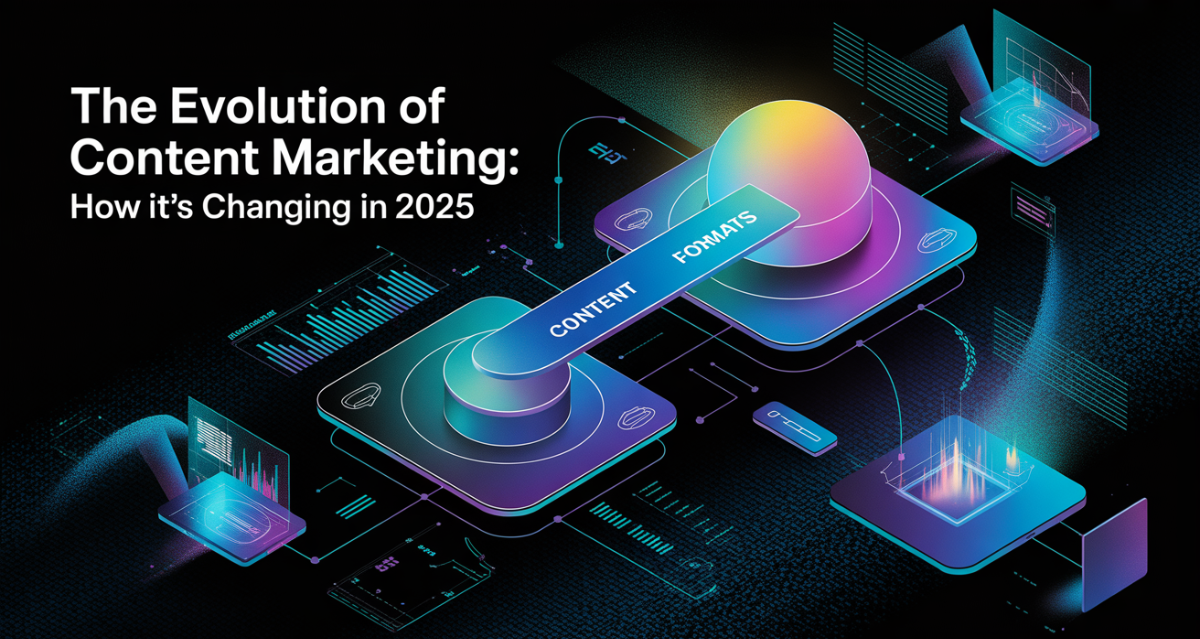
1. The Evolution of Content Marketing
The evolution of content marketing is crucial to note for all businesses seeking to grow in today’s digital world. In two decades, marketing has gone from writing blogs and newsletters to a matrix of hyper-sophisticated individualized media optimized through artificial intelligence. Nowadays, understanding semantic search and aligning messaging to search intent have become increasingly important parts of content marketing, as search engines place a growing focus on UX, Mobile-first strategies, and leveraging Social Media For SEO. The objective is simple: get real ROI, but do so in a way that doesn’t feel forced, gets meaningful engagement, and builds trust with the audience.
2. The Evolution Graph
The evolution of content marketing over the years shows a stark change in strategy. Traditional marketers of yore mainly stuck to on-page SEO and rudimentary off-page tactics —they just had to spit out blog after blog to rank. Today, it is all about quality content EAT (Expertise, Authority, Trust), and actionable analytics. The integration of structured data, by way of schema markup, assists in ensuring the content you publish is semantically optimized for search intent – not only making it easier for search engines to understand, but more importantly, your readers. It involves prioritizing the user, then appeasing algorithms, a very delicate balance.
3. A Quick Timeline
Key Content Milestones On The Road To An Evolution: Blogs & basic SEO were the building blocks in the early 2000s. The trends changed again, thanks to mobile-first strategies and the dawn of social media influencing SEO from 2010-2015. But from 2016–2020, video SEO and interactive content as well as content repurposing, have become crucial in engagement. 2- 2023 AI/ ChatGPT/ other SEO tools moved on how content was written and ranked in 2022-23. Step semantic keyword mapping, data-driven content, and personalization strategies to the forefront of the tools required to satisfy audiences and search engines on every single piece of content by 2024–25
4. Where Are We Going from Here?
That does not mean content marketing is moving human-first, but AI-assisted. Now, marketers have to walk the tightrope between creativity and technology, learning how to produce conversion-centric content effectively, perform semantic analysis of the text, and AI-driven link building, all while also managing the content lifecycle. Most trends, including voice search optimization and automated content creation, encourage brands to incorporate more innovation while doing so without losing the personal element around which their brand image has been designed. Only the people who are able to connect their analytics, AI, and creativity dots will be survivors in this digital volcano.
5. AI Adoption and Modern SEO Tools
Content marketing has advanced massively, all thanks to Artificial Intelligence. AI tools help in kickstarting many strategies, from AI-generated content to predictive SEO trends or NLP-driven research. SEO assistants and semantic keyword mapping provide the necessary information that marketers need to optimize for SERP features, understand how semantic search works, and analyze performance in real time. That description is exactly why those campaigns are effective; they can be measured, targeted, and specific in a way that data is an action plan that informs strategy.
6. Semantic SEO and Entity-Based Strategies
It means that it is an absolute necessity to go towards Semantic SEO and logic based on entities. By grouping content more closely to the concepts and entities that search engines assign authority in, marketers can align with search intent faster, sooner, and with long-lasting topical authority. Using structured data and schema markup can help you get rich snippets in results, therefore visibility in the right side knowledge panel, which means more engagement and organic traffic. This takes SEO far beyond keywords and teaches search engines the context and relevance of content.
7. Interactive and Multi-Format Content
Modern audiences expect variety. Alongside video SEO, interactive blog features, infographics, and even repurposed content help brands tap new users across all possible platforms. It’s multi-format content that enhances engagement, increases social signals, and grabs attention in a low attention span world. A platform like LinkedIn, TikTok, and Email newsletters are part of a content wheel that amplifies reach & engagement
8. Measuring Success with Analytics
Understanding this is the only way to your content marketing analytics. By tracking metrics like organic traffic, engagement, and conversions, you can notice improvement in what works and failure on things that do not. AI-driven audits, predictive analytics, and performance dashboards enable marketers to optimize campaigns, raise content quality, or yield an ROI that turns strategies into reality. With a lack of analytics, even the greatest creative can fail.
9. Conversion-Focused Content Strategy
Content should be more than a traffic driver; it should drive results that your business can measure. Nurturing long-term customers; Data packages, multichannel alignment, personalized content to track readers throughout sales funnels. This will help to make sure that every piece can correlate back to bottom-line business goals with the aid of link-building and long-form SEO AI tools, translating engagement into revenue.
10. Voice Search and Emerging Trends
The 2025 landscape of voice search optimization, including the expected boost of platforms such as smart assistants and mobile voice searches. So what should marketers do? In my opinion we need to keep focus on conversational queries, structured data and of course rich snippets. These shape-changing habits include trends in how people consume content, such as automated content creation and AI-driven personalization; flexible strategies are therefore crucially needed for an audience that can no longer be viewed through a one-size-fits-all lens — human-focused but tech-enabled.
11. Social Signals and SEO Impact
The importance of social media in SEO is still high. It may indirectly affect your ranking as shares, engagement, and brand awareness serve as indirect signals for Google’s ranking. With a bit of information on how social interactions affect search rankings, you can shape your content to appeal to people in a way that will inspire them to share and link and further establish your topic authority. When discussing modern SEO tactics, social signals are the golden goose of any successful campaign today.
12. Balancing Creativity with AI
AI can create content fast and on a larger scale, but AI is creativity impoverished.. To retain authenticity, storytelling, and emotional connection, brands need to couple AI tools with human insight. Guaranteeing that content is not only optimized, but also rewarding to that end, providing experiences which create and retain impressions, thus building loyalty.
13. Subscription-Driven Engagement
Subscription-based content or paid communities result in higher user engagement and a more personalized experience. Restricted viewer access boosts investment, stimulates cross-promotion across channels, and establishes sustainable monetization. Good for building loyal communities and ensuring content of high value gets in front of the most interested audience.
14. Content Personalization Strategies
The cornerstone of modern marketing is personalized content. AI-driven Keyword Research + Semantics Analysis = Predictive Marketers can use AI tools to tailor content for user intent. Skate.gms.BooleanField / gms TrueBigInt It both engages your audience, supports long-tail keyword strategies, and builds topic authority while further making for any interaction a time to connect and (ultimately) convert.
15. Preparing for 2025 and Beyond
The future of content marketing in 2025: hybrid Tech, creativity & strategy combine together. The full entity-based SEO may involve other semantic tactics or inserting another item and locking in that competitive advantage. and brands treating every piece of media produced as a product, combined with the exponential growth in performance through AI analytics, enables brands to rapidly scale impact whilst remaining engaged and relevant in an increasingly noisy digital landscape content as a Product.
FAQ’s
It demonstrates the evolution of what content marketing is?
From the days of simple blogs and newsletters to AI-driven customer-centric ones focusing on semantic search, search intent, UX, and measurable ROI.
Is the future of content marketing in 2025 influenced by AI?
New AI technologies can quickly create content, adjust for search intent, and identify long-tail keywords or predict trends and provide analytics to optimize plans in the field, making campaigns smarter.
3: Why is semantic SEO more important than ever?
Another layer of fine-tuned relevance, semantic SEO makes content understood in terms of context and meaning. It improves relevancy, increases expertise on topics, and evolves search beyond the confines of traditional keyword strategies.
What content types are best to support you now?
The multi-format content, like video, interactive blogs, and infographics, requires the creation of great content that can easily engage the audience and works perfectly well across platforms like LinkedIn, TikTok, as well as email newsletters.
How should businesses be getting ready for 2025 and beyond?
Instead, ensure your exponential organic growth and engagement by shifting towards data-driven content, investing in multi-format interactive, adopting Ai analytics, personalized experiences, and mastering semantic & entity-based SEO.
Conclusion
What used to be simple blogs has developed into a slightly more complex ecosystem, leveraging marketing automation and AI. By 2025, the only way you will be able to succeed is through a mix of AI, semantic SEO, and personalized strategies, coupled with the most powerful ingredient, creativity, combined with audience-first thinking. From cross-format content to interactive experiences and actionable insights, the platform empowers today’s marketer to not only create better relationships and stronger brand equity but also measurable business results. No, only the brands that are under agile frenzy will win this digital war


